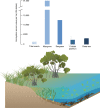The future of Blue Carbon science
- PMID: 31488846
- PMCID: PMC6728345
- DOI: 10.1038/s41467-019-11693-w
The future of Blue Carbon science
Erratum in
-
Author Correction: The future of Blue Carbon science.Nat Commun. 2019 Nov 8;10(1):5145. doi: 10.1038/s41467-019-13126-0. Nat Commun. 2019. PMID: 31705010 Free PMC article.
Abstract
The term Blue Carbon (BC) was first coined a decade ago to describe the disproportionately large contribution of coastal vegetated ecosystems to global carbon sequestration. The role of BC in climate change mitigation and adaptation has now reached international prominence. To help prioritise future research, we assembled leading experts in the field to agree upon the top-ten pending questions in BC science. Understanding how climate change affects carbon accumulation in mature BC ecosystems and during their restoration was a high priority. Controversial questions included the role of carbonate and macroalgae in BC cycling, and the degree to which greenhouse gases are released following disturbance of BC ecosystems. Scientists seek improved precision of the extent of BC ecosystems; techniques to determine BC provenance; understanding of the factors that influence sequestration in BC ecosystems, with the corresponding value of BC; and the management actions that are effective in enhancing this value. Overall this overview provides a comprehensive road map for the coming decades on future research in BC science.
Conflict of interest statement
The authors declare no competing interests.
Figures


References
-
- Nellemann C., et al. (eds) Blue Carbon. A Rapid Response Assessment. United Nations Environment Programme (GRID-Arendal, 2009). This report was the first to use the term ‘blue carbon’
-
- Duarte CM, Losada IJ, Hendriks IE, Mazarrasa I, Marba N. The role of coastal plant communities for climate change mitigation and adaptation. Nat. Clim. Change. 2013;3:961–968.
-
- McLeod E, et al. A blueprint for blue carbon: toward an improved understanding of the role of vegetated coastal habitats in sequestering CO2. Front. Ecol. Environ. 2011;9:552–560.
-
- Macreadie Peter I, Serrano O, Maher Damien T, Duarte Carlos M, Beardall J. Addressing calcium carbonate cycling in blue carbon accounting. Limnol. Oceanogr. Lett. 2017;2:195–201.
-
- Howard J, et al. Clarifying the role of coastal and marine systems in climate mitigation. Front. Ecol. Environ. 2017;15:42–50.
Publication types
LinkOut - more resources
Full Text Sources

